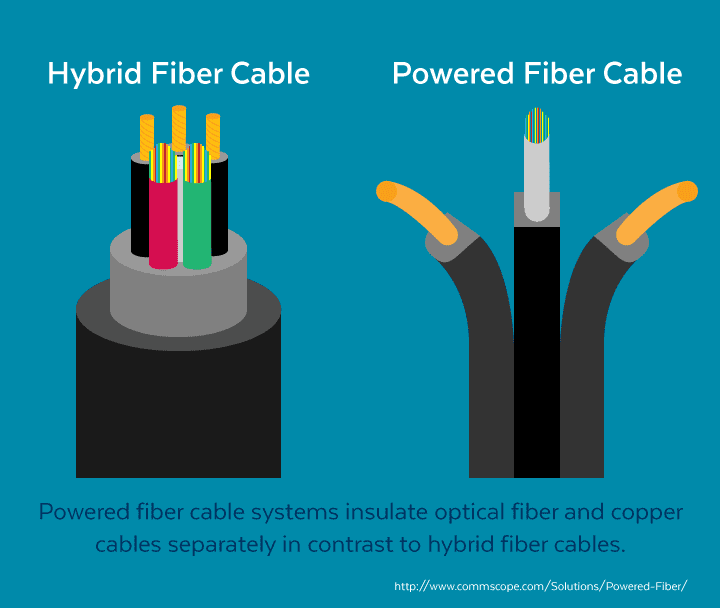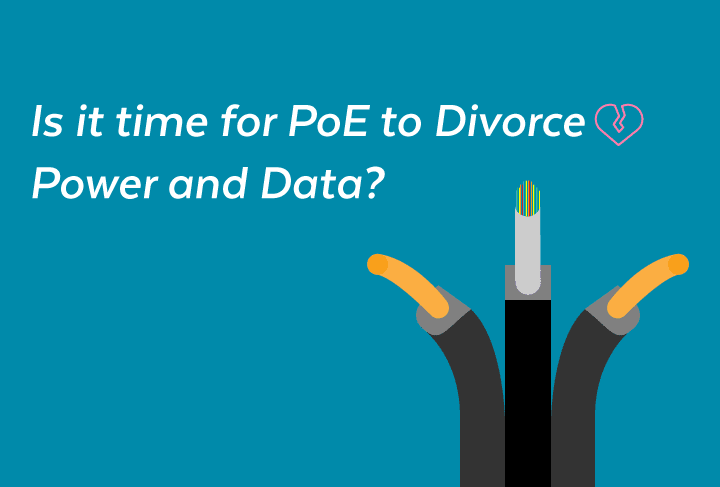Power over Ethernet (PoE) is known for its simultaneous transmission of power and data using twisted pair copper, but will the search for faster speed rates influence the separation of data and power?
New Powered Fiber Cable System (PFCS) solutions introduce a new breed of PoE extension. The solution utilizes a powered fiber cable that insulates fiber and copper separately and assigns copper with one sole purpose—to transmit power.
Understanding PoE’s 100 Meter Limitation
Each new 802.3 PoE standard tends to introduce higher power outputs. IEEE’s initial 802.3af PoE standard introduced compliance for 15 watts of power (12.95 with power dissipation). The standard was followed by 802.3at, also known as PoE+, and introduced compliance for 30 watts of power (25.4 watts of power). IEEE is currently studying 802.3bt, also known as PoE ++, a new standard that aims to provide up to 80 watts of power by using all four twisted copper pairs to transmit data and power. But though new standards seem to be improving upon output power, each new standard fails to improve the maximum supported distance of 100 meters—the standard Ethernet limitation.
Copper has the ability to transmit power to longer distances; however, the range of PoE is limited by copper’s inability to transmit data to ranges that exceed 100 meters. Optical fiber can transmit up to 100 Terabits per seconds. Copper cables are able to transmit gigabit speeds and up to 10 Gbps with newer networking cables such as Cat6 and Cat7. For the time being, 10 Gbps transfer speeds are sufficient for even the most data-hungry Internet users. Nonetheless, optical fiber easily surpasses 100 meter distances. Fiber cable systems with new powered fiber cables can achieve up to 3,000 meters.
Approximating Power over Fiber
Commscope has designed a new powered fiber cable that insulates the optical fiber cable and copper wire within their own separate jackets. The new design deviates from traditional hybrid optical fiber cables that insulate both types of mediums within the same jacket. Network installers can easily peel the cables apart for quick access. The new cabling requires no other special tools besides a wire stripper. These new types of powered fiber cables are quite flexible in comparison to traditional hybrid fiber cables.

Though the solution can’t exactly be described as Power over Fiber, the optical fiber and copper cabling run alongside each other and leverages the same benefit that PoE provides—the ability to deploy powered devices at any location without having to rely on local power supplies.
The ability to install devices without relying on local power supplies, along with its simple ‘plug-and-play’ installation, makes PoE an essential component of networking topologies. But PoE faces a standard 100 meter limitation which forces network administrators to rely on additional equipment such as PoE extenders and media converters to extend network connections beyond Ethernet’s standard 100 meter limitation.
This new breed of PoE extenders will eliminate the need for additional extender kits and simplify network connections.
Leveraging the Power of Copper and Fiber—Separately
Electrical Engineer Bill Schweber observes that the effectiveness of powered fiber systems stems from separating optical fiber and copper. He remarks that the simultaneous transmission of power and data in standard networking cables “require significant “negotiation” and confirmation between the source and load, between intervening ICs and, in order to assure that power is available and acceptable by a peripheral, that there are no conflicts in hardware or software.” Powered fiber cable systems eliminate power negotiations and reserves optical fiber for data transmission and copper wiring for power transmission.
The electrical engineer comments that “PFCS [Powered Fiber Cable Systems] seems to me to be a clever scheme, since it leverages the advantages of each medium (optical+copper, PoE) without either one getting in the way of the other one, and the associated complexity.” Schweber concludes “that by using the long run of copper just for power and not for data, the technical difficulties will be reduced while the performance will be more consistent and easier to manage”. Separating data and power allows copper to deliver power output ranges that exceed the current 802.3at standard of 30 watts. And optical fiber speeds will be able to deliver transmission speeds that surpass 10Gbps to future powered devices.
Additional Benefits of Powered Fiber Cable Systems
According to Aruba Networks, Powered Fiber Cable Systems “Greatly speed up planning by eliminating DC electrical calculations for voltage/power drop over varying distances”. These devices can support up to 32 devices from a centrally located USPs. Powered Fiber Cable Systems essentially operate similar to long extension cords.
It’s highly unlikely that IEEE will divorce Power from Data when it comes to PoE. PoE is ideal for home and enterprise networks, even with a 100 meter Ethernet limitation. And in the cases where powered devices need to be installed beyond 100 meters, there are a myriad of PoE extender options such as fiber media extenders, UTP Ethernet Extenders, and coaxial cable extenders for example, that effectively bypass the limited distance and preserve speed.
Click here to view our interactive infographic explaining the top methods used to extend Ethernet.
Related Posts:


